High-Temperature Effect on the Tensile Mechanical Properties of Unidirectional Carbon Fiber-Reinforced Polymer Plates
Abstract
:1. Introduction
2. Experimental Program
2.1. Test Specimens
2.2. Test Device and Procedure
3. Test Results
3.1. Strength and Elastic Modulus
3.2. Failure Modes
3.2.1. Mode I
3.2.2. Mode II
3.2.3. Mode III
4. Summary and Conclusions
Author Contributions
Funding
Institutional Review Board Statement
Informed Consent Statement
Data Availability Statement
Acknowledgments
Conflicts of Interest
References
- Nigro, E.; Cefarelli, G.; Bilotta, A.; Manfredi, G.; Cosenza, E. Fire resistance of concrete slabs reinforced with FRP bars. Part I: Experimental investigations on the mechanical behavior. Compos. Part B Eng. 2011, 42, 1739–1750. [Google Scholar] [CrossRef]
- ACI. ACI 440.4R-04. Prestressing Concrete Structure with FRP Tendons; American Concrete Institute: Farmington Hills, MI, USA, 2004. [Google Scholar]
- Xie, W.; Zhang, W.; Kuang, N.; Li, D.; Huang, W.; Gao, Y.; Ye, N.; Guo, L.; Ren, P. Experimental investigation of normal and oblique impacts on CFRPs by high velocity steel sphere. Compos. Part B Eng. 2016, 99, 483–493. [Google Scholar] [CrossRef]
- Nigro, E.; Cefarelli, G.; Bilotta, A.; Manfredi, G.; Cosenza, E. Guidelines for flexural resistance of FRP reinforced concrete slabs and beams in fire. Compos. Part B Eng. 2014, 58, 103–112. [Google Scholar] [CrossRef]
- Mahieux, C.; Reifsnider, K. Property modeling across transition temperatures in polymers: A robust stiffness–temperature model. Polymer 2001, 42, 3281–3291. [Google Scholar] [CrossRef]
- Firmo, J.P.; Correia, J.R.; Bisby, L.A. Fire behaviour of FRP-strengthened reinforced concrete structural elements: A state-of-the-art review. Compos. Part B Eng. 2015, 80, 198–216. [Google Scholar] [CrossRef]
- Grape, J.A.; Gupta, V. The effect of temperature on the strength and failure mechanisms of a woven carbon/polyimide laminate under compression. Mech. Mater. 1998, 30, 165–180. [Google Scholar] [CrossRef]
- Dang, M.-G.; Li, D.-S.; Jiang, L. Temperature effects on mechanical response and failure mechanism of 3D angle-interlock woven carbon/epoxy composites. Compos. Commun. 2020, 18, 37–42. [Google Scholar] [CrossRef]
- Cao, S.; Wang, X.; Wu, Z. Evaluation and prediction of temperature-dependent tensile strength of unidirectional carbon fibre-reinforced polymer composites. J. Reinf. Plast. Compos. 2011, 30, 799–807. [Google Scholar]
- Ashrafi, H.; Bazli, M.; Najafabadi, E.P.; Oskouei, A.V. The effect of mechanical and thermal properties of FRP bars on their tensile performance under elevated temperatures. Constr. Build. Mater. 2017, 157, 1001–1010. [Google Scholar] [CrossRef]
- Zhou, F.; Zhang, J.; Song, S.; Yang, D.; Wang, C. Effect of temperature on material properties of carbon fiber reinforced polymer (CFRP) tendons: Experiments and model assessment. Materials 2019, 12, 1025. [Google Scholar] [CrossRef] [PubMed] [Green Version]
- Hawileh, R.; Abu-Obeidah, A.; Abdalla, J.A.; Al-Tamimi, A. Temperature effect on the mechanical properties of carbon, glass and carbon–glass FRP laminates. Constr. Build. Mater. 2015, 75, 342–348. [Google Scholar] [CrossRef]
- Bisby, L.A. Fire Behaviour of FRP Reinforced or Confined Concrete. Ph.D. Thesis, Department of Civil Engineering, Queen’s University, Kingston, ON, Canada, 2003. [Google Scholar]
- Wang, K.; Young, B.; Smith, S. Mechanical properties of pultruded carbon fibre-reinforced polymer (CFRP) plates at elevated temperatures. Eng. Struct. 2011, 33, 2154–2161. [Google Scholar] [CrossRef]
- Feih, S.; Mouritz, A.P. Tensile properties of carbon fibres and carbon fibre–polymer composites in fire. Compos. Part A Appl. Sci. Manuf. 2012, 43, 765–772. [Google Scholar] [CrossRef] [Green Version]
- Gates, T.S.; Su, X.; Abdi, F.; Odegard, G.M.; Herring, H.M. Facesheet delamination of composite sandwich materials at cryogenic temperatures. Compos. Sci. Technol. 2006, 66, 2423–2435. [Google Scholar] [CrossRef] [Green Version]
- Salehi-Khojin, A.; Mahinfalah, M.; Bashirzadeh, R.; Freeman, B. Temperature effects on Kevlar/hybrid and carbon fiber composite sandwiches under impact loading. Compos. Struct. 2007, 78, 197–206. [Google Scholar] [CrossRef]
- Garrido, M.; Correia, J.R.; Keller, T. Effect of service temperature on the shear creep response of rigid polyurethane foam used in composite sandwich floor panels. Constr. Build. Mater. 2016, 118, 235–244. [Google Scholar] [CrossRef]
- Zhou, J.; Wang, Y.; Liu, J.; Liu, J.; Mei, J.; Huang, W.; Tang, Y. Temperature effects on the compressive properties and failure mechanisms of composite sandwich panel with Y-shaped cores. Compos. Part A Appl. Sci. Manuf. 2018, 114, 72–85. [Google Scholar] [CrossRef]
- Yu, B.; Kodur, V. Effect of temperature on strength and stiffness properties of near-surface mounted FRP reinforcement. Compos. Part B Eng. 2014, 58, 510–517. [Google Scholar] [CrossRef]
- Xu, J.; Wang, W.; Han, Q. Mechanical properties of pultruded high-temperature-resistant carbon-fiber-reinforced polymer tendons at elevated temperatures. Constr. Build. Mater. 2020, 258, 119526. [Google Scholar] [CrossRef]
- ASTM. ASTM D3039/D 3039M–08. Standard Test Method for Tensile Properties of Polymer-Matrix Composite Materials; ASTM: West Conshohocken, PA, USA, 2008. [Google Scholar]

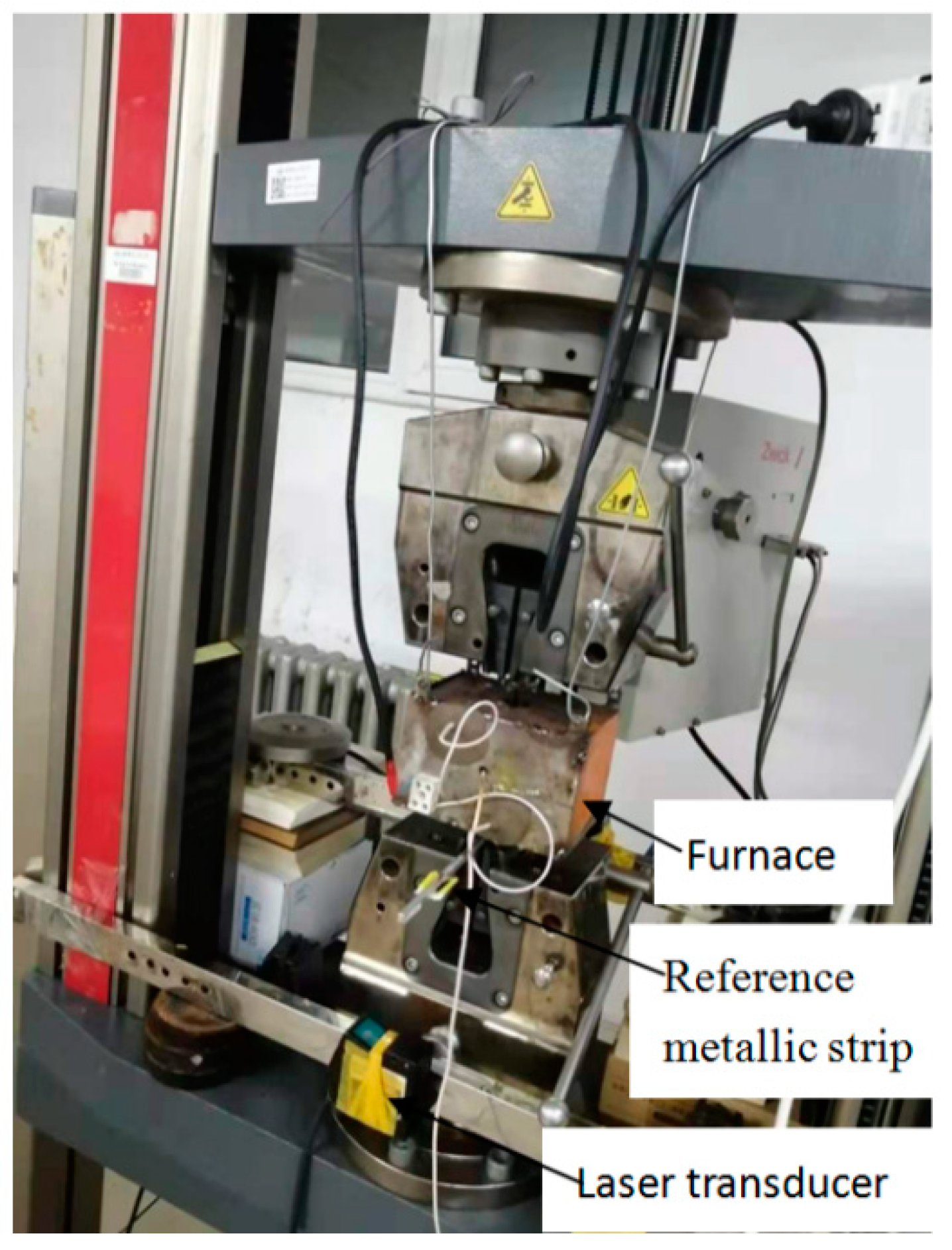
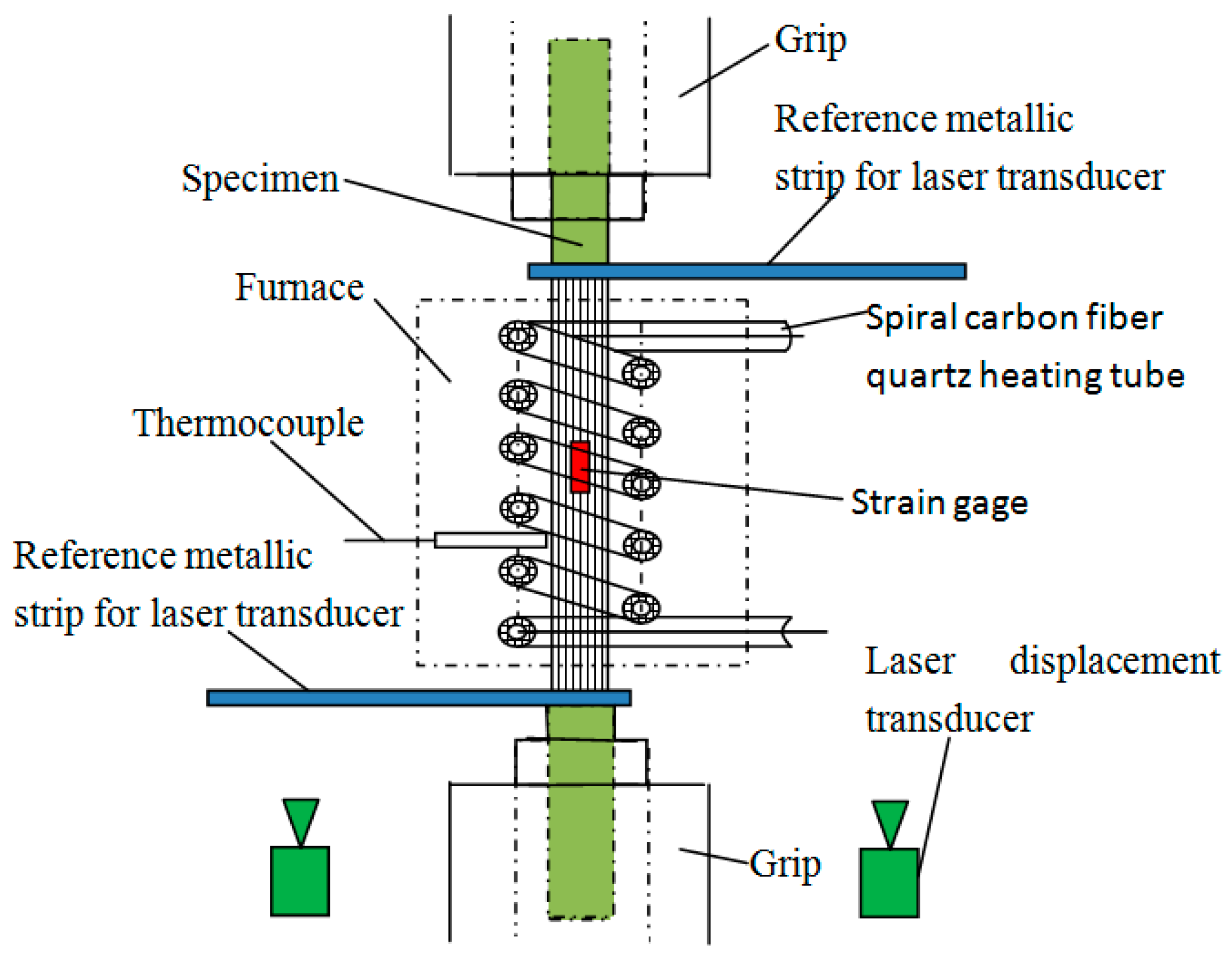
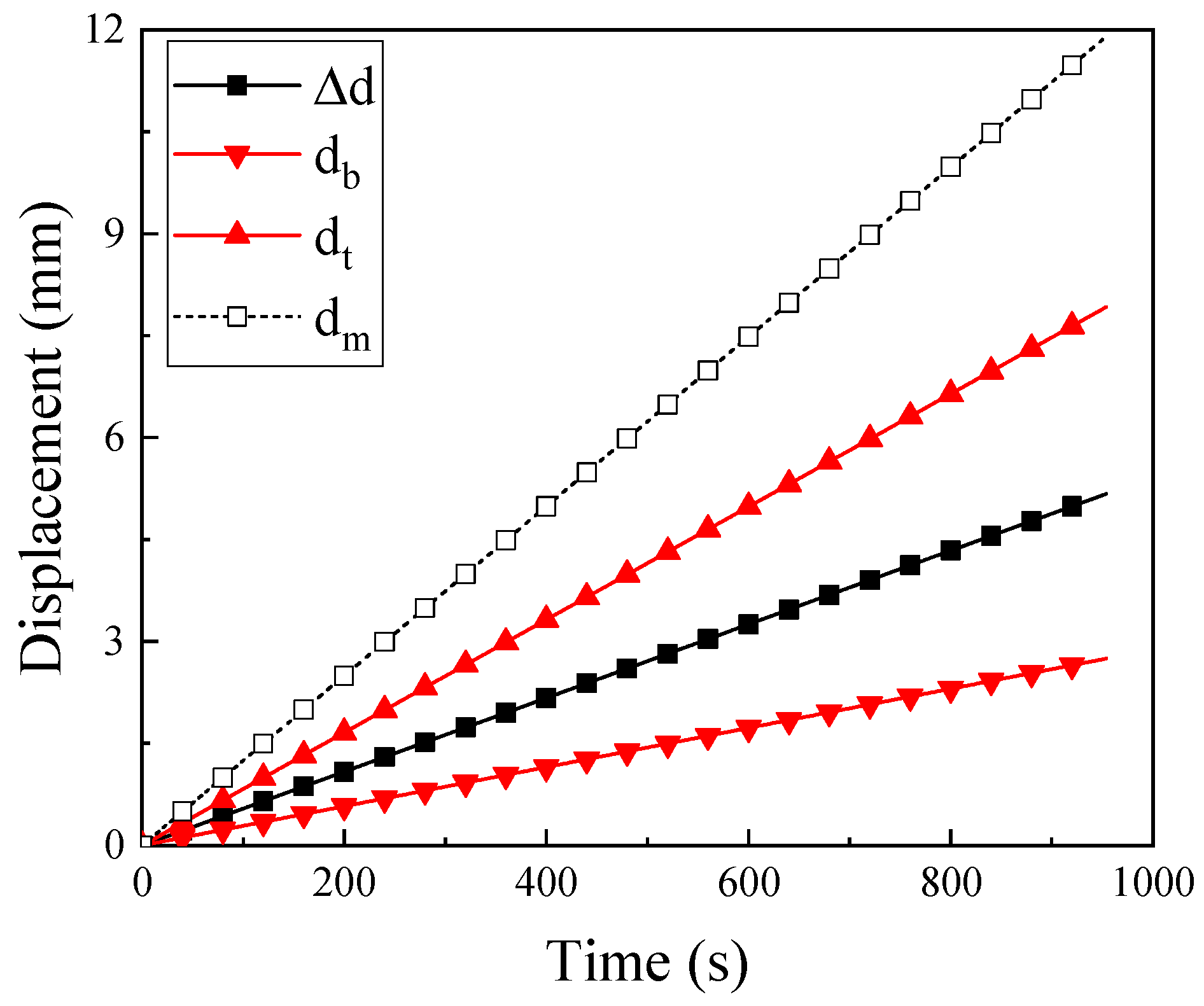
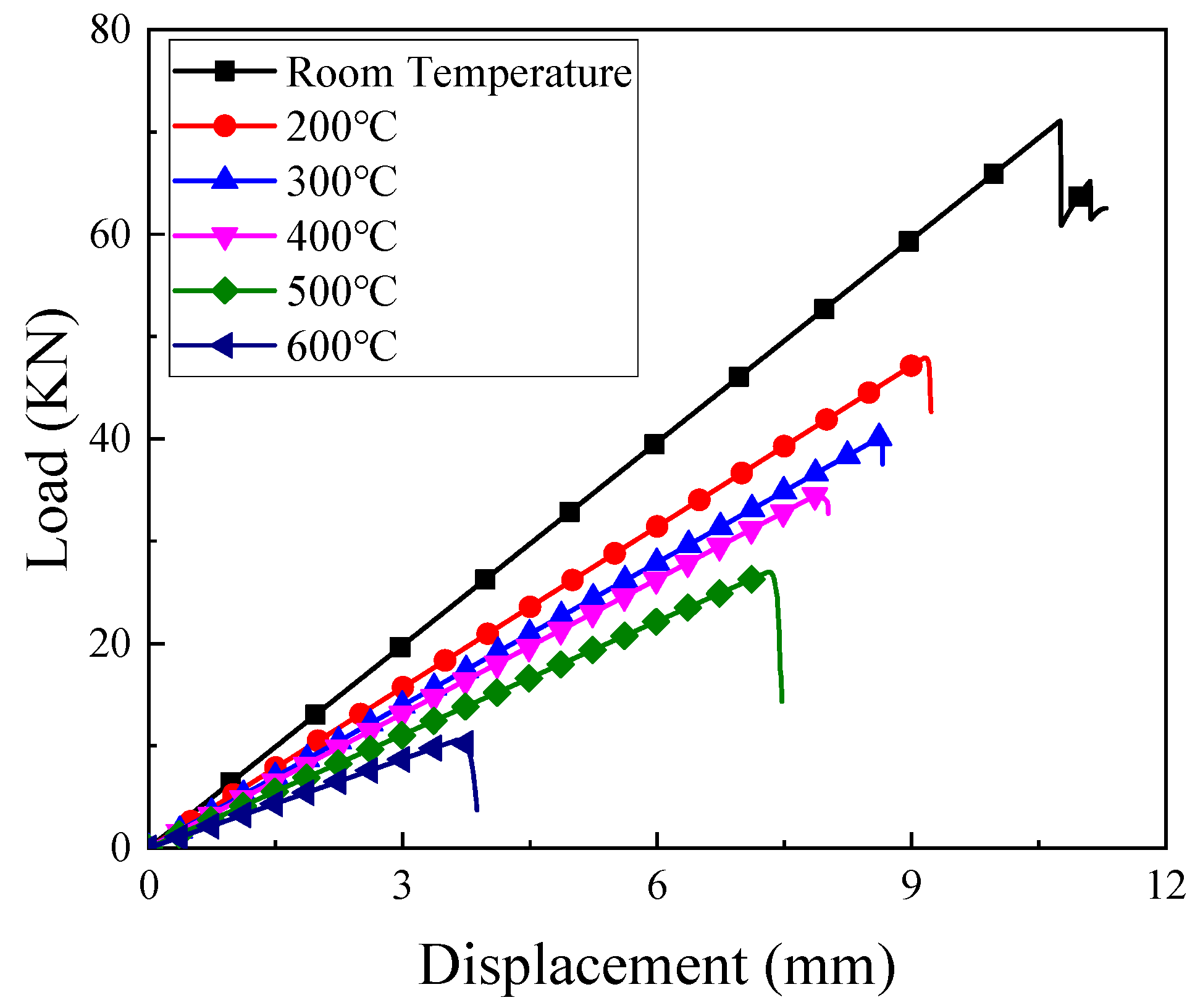
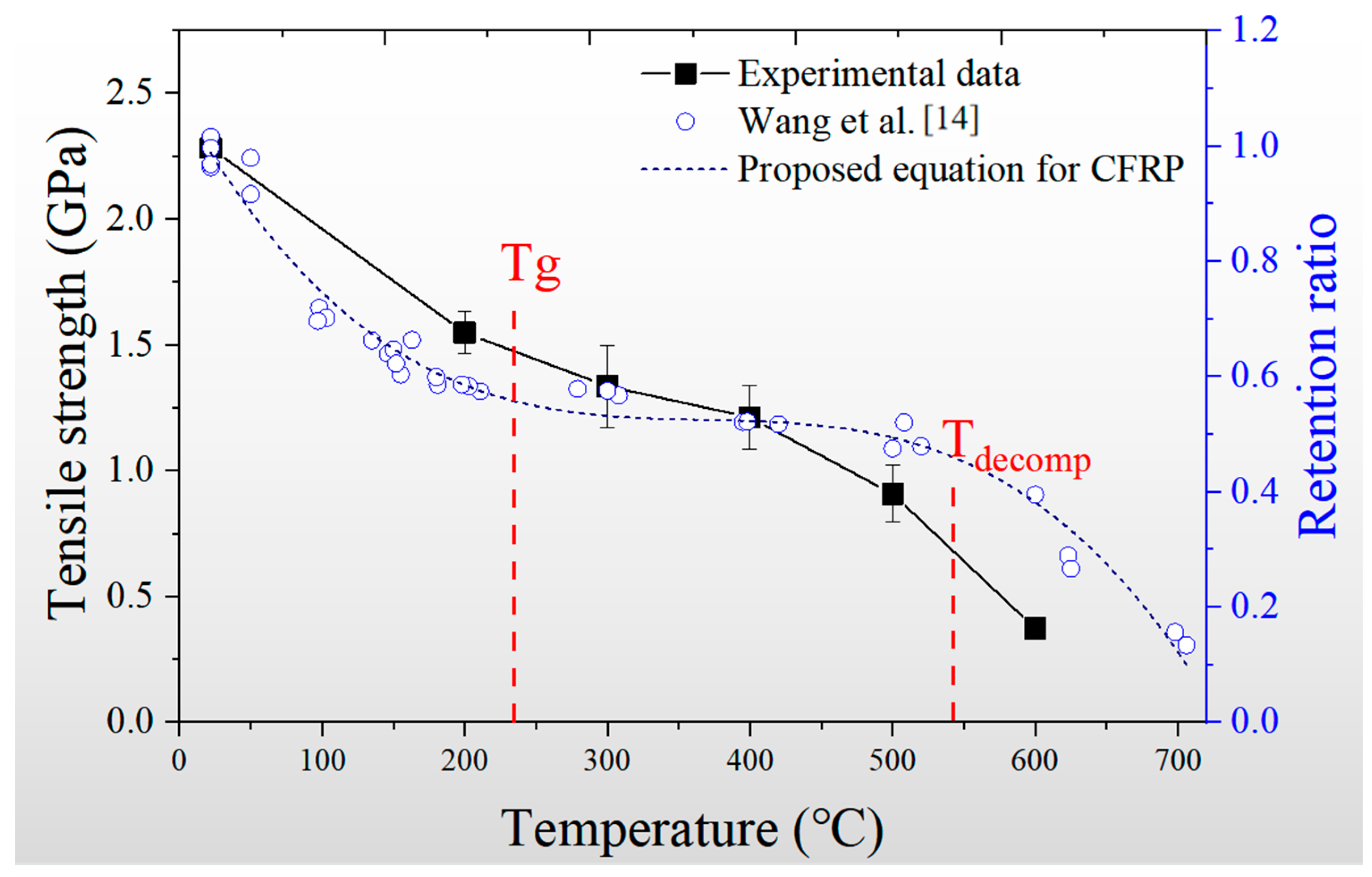
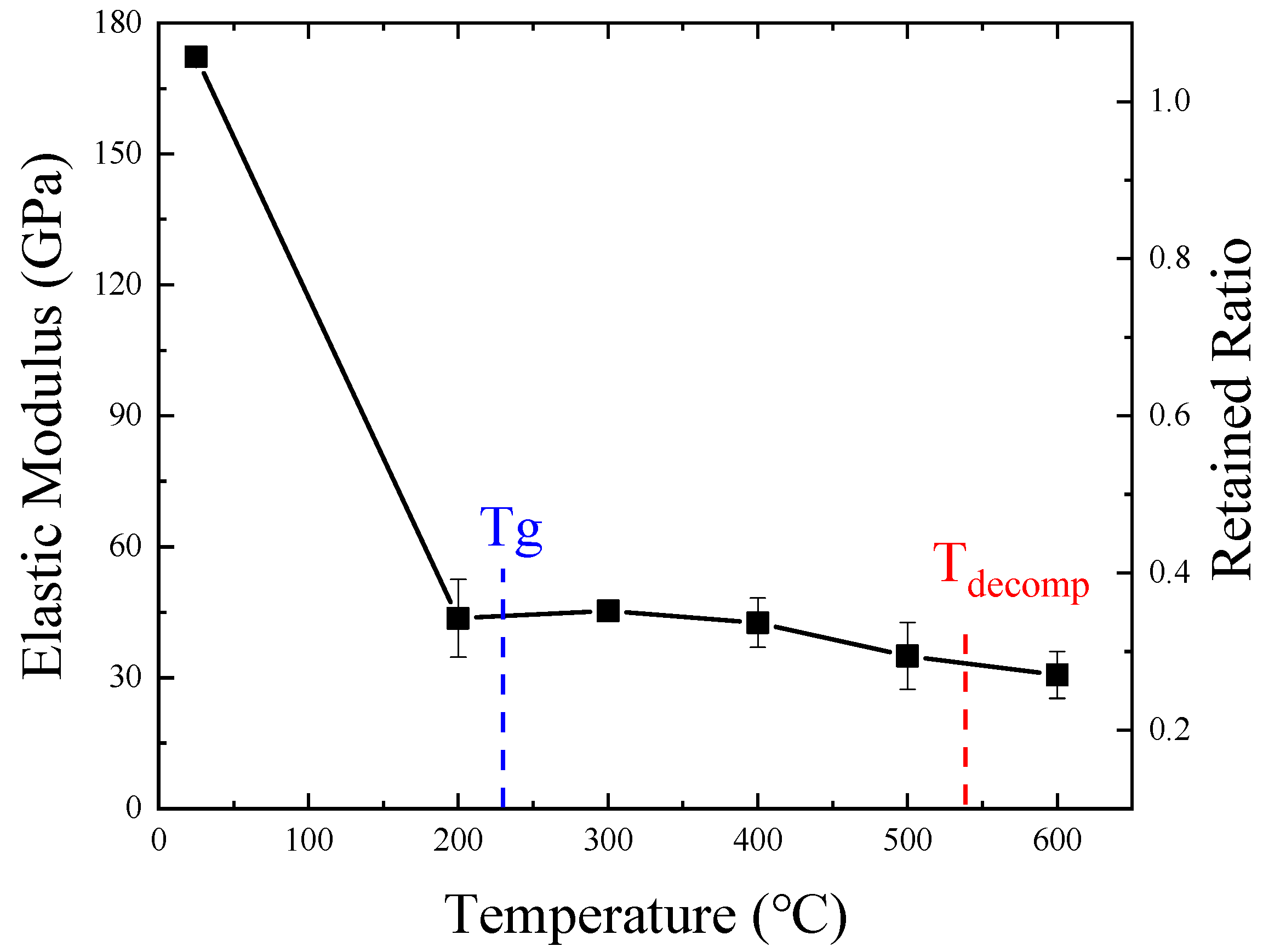
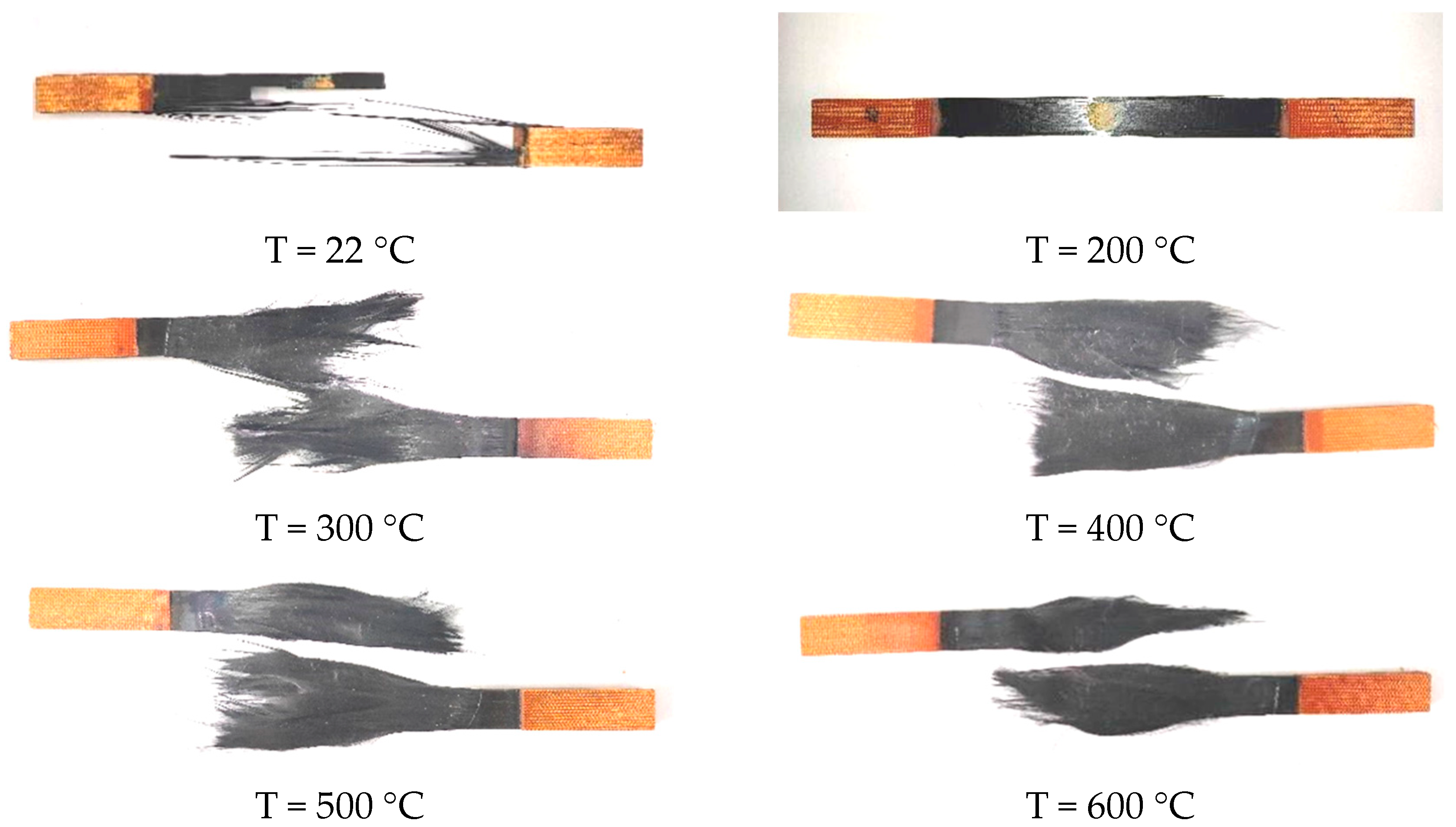

| Material | Type | Tensile Strength (MPa) | Tensile Modulus (GPa) | Elongation (%) | Density (g/cm3) | Tg (°C) |
|---|---|---|---|---|---|---|
| Carbon fiber | SYT55S-12K | 5900 | 295 | 1.9 | 1.79 | - |
| Resin | BA 202 | 80 | 3.5 | 2.9–3.8 | 1.17 | 230–235 |
| Thickness (mm) | Fiber Content by Volume % | Tensile Strength (MPa) | Tensile Modulus (GPa) | Fracture Strain % | ||
|---|---|---|---|---|---|---|
| Mean | Min | Mean | Min | |||
| 2.0 | 68 ± 2 | 2300 | 2227 | 172 | 171 | 1.7 |
| No. | Temperature (°C) | Tensile Strength (MPa) | Poisson’s Ratio | Strain (uε) | Average Strength (MPa) | Retention Ratio | Failure Mode |
|---|---|---|---|---|---|---|---|
| T1-1 | 22 | 2385.596 | 0.317 | 15,775 | 2281.71 | 1 | I |
| T1-2 | 2227.756 | 0.330 | 17,516 | I | |||
| T1-3 | 2280.480 | 0.332 | 15,735 | I | |||
| T1-4 | 2268.118 | 0.332 | 15,772 | I | |||
| T1-5 | 2246.586 | 0.329 | 16,498 | I | |||
| T2-1 | 200 | 1552.713 | 0.187 | 35,112 | 1547.58 | 0.68 | I |
| T2-2 | 1467.448 | 0.183 | 6638 | I | |||
| T2-3 | 1461.829 | 0.140 | 6391 | I | |||
| T2-4 | 1657.283 | 0.176 | 28,571 | I | |||
| T2-5 | 1598.628 | 0.179 | 30,683 | I | |||
| T3-1 | 300 | 1442.481 | -- | 32,920 | 1335.03 | 0.59 | II |
| T3-2 | 1487.260 | -- | 31,923 | II | |||
| T3-3 | 1087.198 | -- | 46,630 | II | |||
| T3-4 | 1401.766 | -- | 38,720 | II | |||
| T3-5 | 1256.426 | -- | 35,209 | II | |||
| T4-1 | 400 | 1191.488 | -- | 33,157 | 1211.56 | 0.53 | III |
| T4-2 | 1323.174 | -- | 28,538 | III | |||
| T4-3 | 1052.650 | -- | 26,440 | III | |||
| T4-4 | 1138.193 | -- | 27,230 | III | |||
| T4-5 | 1352.295 | -- | 27,061 | III | |||
| T5-1 | 500 | 1042.207 | -- | 19,660 | 906.32 | 0.40 | III |
| T5-2 | 992.776 | -- | 30,820 | III | |||
| T5-3 | 765.653 | -- | 24,480 | III | |||
| T5-4 | 834.294 | -- | 20,896 | III | |||
| T5-5 | 896.661 | -- | 22,916 | III | |||
| T6-1 | 600 | 409.165 | -- | 10,630 | 371.95 | 0.16 | III |
| T6-2 | 367.555 | -- | 13,018 | III | |||
| T6-3 | 317.591 | -- | 13,307 | III | |||
| T6-4 | 378.910 | -- | 12,040 | III | |||
| T6-5 | 386.550 | -- | 12,461 | III |
| No. | Temperature (°C) | Tensile Modulus (GPa) | Average Modulus (GPa) | Retention Ratio |
|---|---|---|---|---|
| T1-1 | 22 | 173.631 | 171.16 | 1 |
| T1-2 | 171.531 | |||
| T1-3 | 171.303 | |||
| T1-4 | 169.083 | |||
| T1-5 | 170.289 | |||
| T2-1 | 200 | 44.221 | 50.48 | 0.29 |
| T2-2 | 51.303 | |||
| T2-3 | 47.947 | |||
| T2-4 | 55.685 | |||
| T2-5 | 53.293 | |||
| T3-1 | 300 | 50.379 | 38.88 | 0.23 |
| T3-2 | 46.588 | |||
| T3-3 | 23.315 | |||
| T3-4 | 36.202 | |||
| T3-5 | 37.958 | |||
| T4-1 | 400 | 35.894 | 42.59 | 0.25 |
| T4-2 | 46.365 | |||
| T4-3 | 38.944 | |||
| T4-4 | 41.798 | |||
| T4-5 | 49.975 | |||
| T5-1 | 500 | 46.365 | 36.74 | 0.21 |
| T5-2 | 32.212 | |||
| T5-3 | 31.276 | |||
| T5-4 | 37.549 | |||
| T5-5 | 36.318 | |||
| T6-1 | 600 | 38.521 | 30.61 | 0.18 |
| T6-2 | 28.233 | |||
| T6-3 | 23.878 | |||
| T6-4 | 31.402 | |||
| T6-5 | 31.028 |
Publisher’s Note: MDPI stays neutral with regard to jurisdictional claims in published maps and institutional affiliations. |
© 2021 by the authors. Licensee MDPI, Basel, Switzerland. This article is an open access article distributed under the terms and conditions of the Creative Commons Attribution (CC BY) license (https://creativecommons.org/licenses/by/4.0/).
Share and Cite
Zhang, Y.; Li, Y.; Zhang, J.; Pan, J.; Zhang, L.; Tan, F.; Wei, H.; Zhang, W. High-Temperature Effect on the Tensile Mechanical Properties of Unidirectional Carbon Fiber-Reinforced Polymer Plates. Materials 2021, 14, 7214. https://doi.org/10.3390/ma14237214
Zhang Y, Li Y, Zhang J, Pan J, Zhang L, Tan F, Wei H, Zhang W. High-Temperature Effect on the Tensile Mechanical Properties of Unidirectional Carbon Fiber-Reinforced Polymer Plates. Materials. 2021; 14(23):7214. https://doi.org/10.3390/ma14237214
Chicago/Turabian StyleZhang, Yongqiang, Yue Li, Jialei Zhang, Jinwu Pan, Li Zhang, Fuli Tan, Hongjian Wei, and Wei Zhang. 2021. "High-Temperature Effect on the Tensile Mechanical Properties of Unidirectional Carbon Fiber-Reinforced Polymer Plates" Materials 14, no. 23: 7214. https://doi.org/10.3390/ma14237214
APA StyleZhang, Y., Li, Y., Zhang, J., Pan, J., Zhang, L., Tan, F., Wei, H., & Zhang, W. (2021). High-Temperature Effect on the Tensile Mechanical Properties of Unidirectional Carbon Fiber-Reinforced Polymer Plates. Materials, 14(23), 7214. https://doi.org/10.3390/ma14237214





